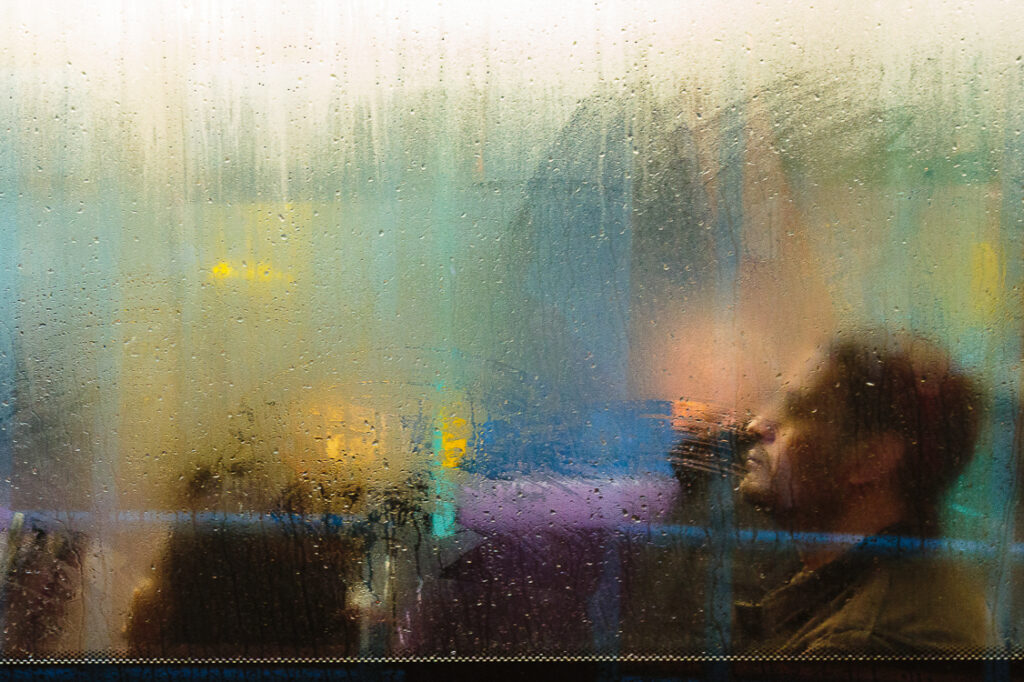Cameron’s interest in photography started when he joined the camera club at school and was introduced to the joys of wet processing in their darkroom. The idea of being able to freeze an instant in time appealed to him, particularly the ability to capture the complexity of human emotions in a single image. Most of his street photography has been done in Glasgow – he tried Edinburgh but it wasn’t the same.
He said that street photography was not really considered a ‘genre’ until the turn of the millennium. He gave us descriptions of several related genres that can be distinguished. Street Photography is about telling a story in a single image. Documentary Photography is about telling a story over many images. Photojournalism is about recording events sometimes with a written commentary. I think what our own street photographer, Paul, captures so well does not fit into any of these categories and would probably class as Street Portraiture.
Cameron said that what he does mostly nowadays is Photojournalism as he likes working in themes. Currently he works exclusively in black and white although over his career he has flirted with colour. He did a successful series in colour entitled Life Through a Bus Window – you can see these images here: Life Through A Bus Window by Cameron Scott — Progressive Street. He admitted to pressing the button on a controlled pedestrian crossing in a one-way street to stop buses in order to take the pictures! However, with colour photography, colour becomes the subject of the composition and can detract from the story-telling when that is the point of the picture.
He belonged to a camera club for a while. As we all know, a lot can be learned from the comments on our work by external judges. The downside is that they favour the ‘pictorial’ style of photo, so emphasis and rewards are given for aspects like focal points, simplicity, the ‘rules of composition’, removal of distractions, avoid splitting image into two halves etc. Storytelling appears to be of lesser importance. Don’t you feel sometimes that we are being groomed by judges to favour a particular style of photography when there are so many opportunities to try other genres?
Street photography is inherently messy and does not usually fare well in many competitions. Cameron said that his work soon developed a following on social media such as Facebook and Instagram and other online collectives like Progressive-Street and the Centre for British Documentary Photography. This gave him the incentive to continue with his love of this kind of work.
The law in the UK allows the freedom to take photos in public places. However, other considerations like ethics and common sense must come into play. For example, he avoids taking pictures of homeless people or others in dire circumstances.
He mentioned Robert Capa’s dictum ‘If your pictures are not good enough, you’re not close enough.’ It helps getting in close having a small camera, so he sold his Canon SLR and now uses a Lumix G9. He takes exclusively in landscape format using wide-angle lenses – 16 mm or a 8- 18 mm lens (16-38 full frame equivalent). He tends to leave the camera on aperture priority with the camera on f4 generally getting shutter speeds of about 1/320 sec.
Although his camera takes the images in full colour, he uses a Preset in Lightroom that converts it to a black and white image to match the normally gloomy light conditions found in Glasgow. So he doesn’t look at the colour version or do much in the way of photo editing.
In street photography, he sees the people as actors in a scene rather than subjects of the photo. Things can happen very quickly and only practice can help develop a sixth sense of what will happen next and give you a chance to capture that telling facial expression or hand gesture that will tell the story. It was interesting to hear that Cameron was a jazz musician and that he drew a parallel between street photography and jazz improvisation. Both rely on a high level of technical skill and an ability to rely on instinct.
He told us about the photographers he had been influenced by. A long list, some you will know about but many you wouldn’t have heard of. I will simply list them here should you want to look up some of their work: Walker Evans, Henri Cartier-Bresson, W. Eugene Smith, Robert Frank, Garry Winegrand, Elliot Erwitt, Daido Moriyama, Joel Meyerowitz, Alex Webb, Harry Gruyaert, Saul Leiter, Chris Steel-Perkins, Trish Murtha and Chris Killip.
Cameron concluded the evening with pictures from a recent year-long commission to record the harrowing experiences of paramedics dealing with casualties on streets in Glasgow.
To see more of Cameron’s work, visit his website Cameron Scott Street Photography.
He has kindly supplied some of the images he showed us to illustrate this blog.
Thank you Cameron for a fascinating, thought-provoking evening.













0 Comments